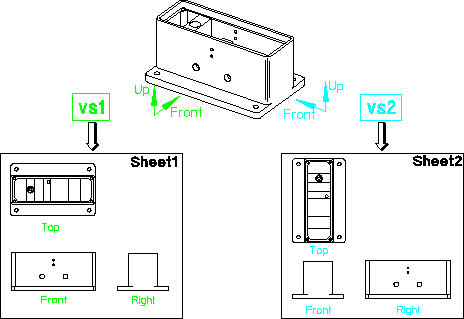What are view sets?
Creo Elements/Direct Annotation uses view sets to define the link between a 3D model and 2D views. A view set determines the owning part or assembly and its direction in space for views. Creo Elements/Direct Annotation creates view sets automatically and re-uses them when possible.
Creo Elements/Direct Annotation bases the orthographic views (front, top, right, back, bottom, left) and the isometric views on the Up and Front direction parameters.
Example 1
The figure shows a Creo Elements/Direct Modeling model. The three views (Top, Front, and Right) shown in Sheet1 are derived from the view set vs1. The three views shown in Sheet2 are derived from the view set vs2.

This simple example demonstrates the outcome of defining two different viewing directions for the same part. The next example shows why view sets can be particularly useful when working with complex parts and assemblies, by allowing you to mix viewing directions on one sheet.
Example 2
A view set can be defined for each part of an assembly. The figure shows a simple assembly containing three parts. The top picture (1) shows the front view based on the view set vs1 owned by the whole assembly. The bottom picture (2) shows the result when each part is assigned a different view set. Here, part p1 is described by view set vs1 (owned by p1) and part p2 is described by view set vs2 (owned by p2). The advantage of multiple view sets becomes apparent with part p3 because the view set owned by p3 is defined to show the true shape of the inclined face and not a projected shape.

Multiple view sets are particularly useful for showing, for example, an exploded view of an assembly or part-part positioning relationships.